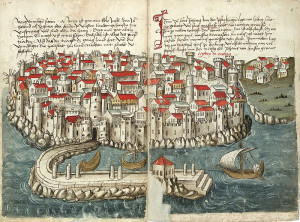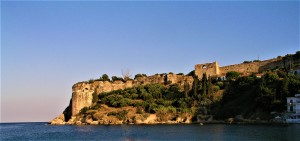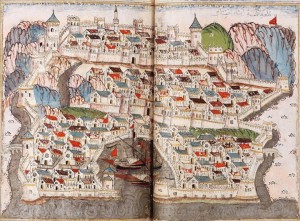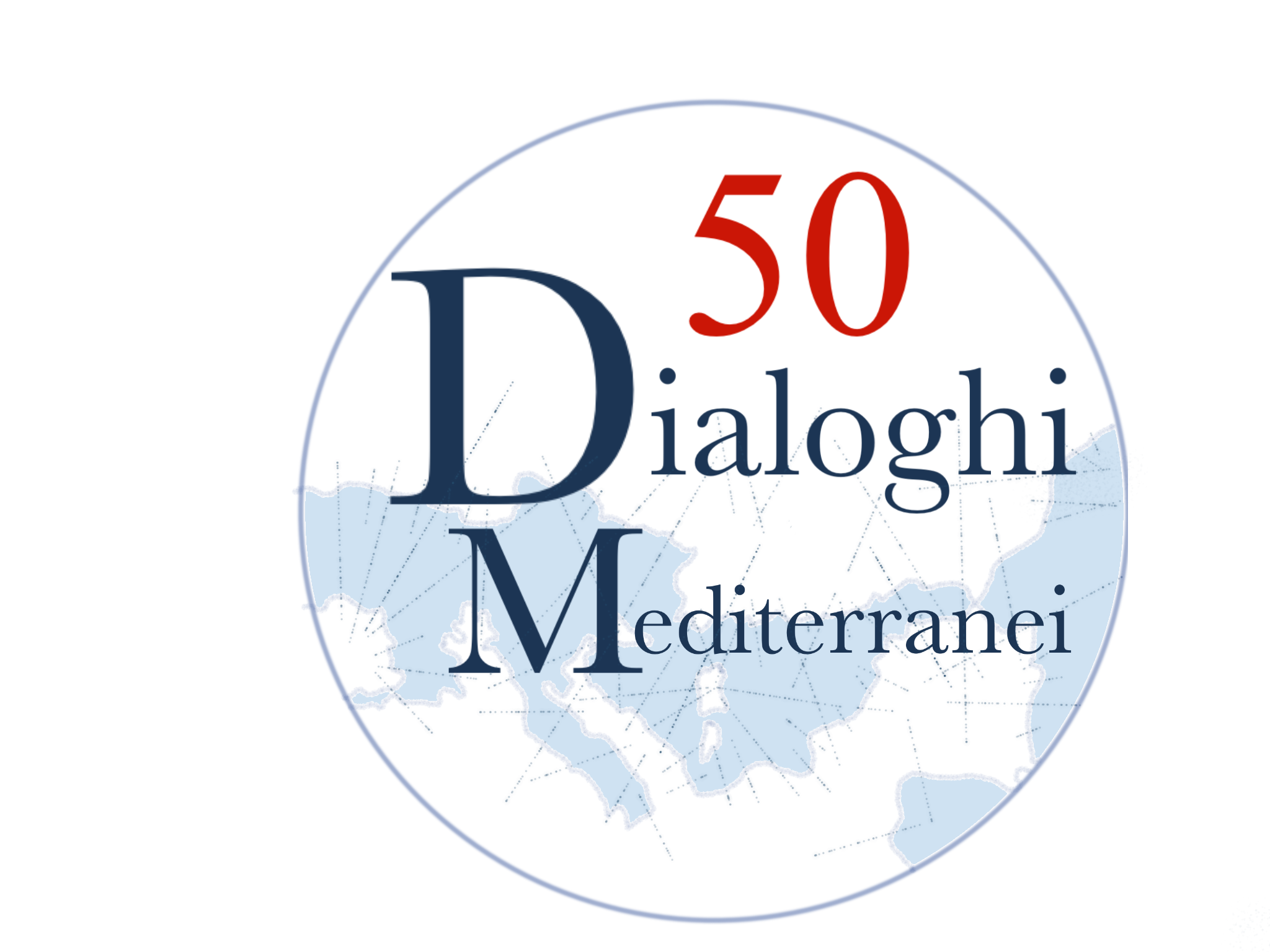di Arnold Cassola [*]
In December 1564 Süleyman was informing Dragut (Turgut Reis) that Piyale Paşa, the beylerbeyi [1] of the Archipelago (Greek Aegean Islands), was being appointed commander of the Imperial Navy and being asked to join in the Siege of Malta.
On the 5 Cemaziyelâhir 972 (8th January 1565) Süleyman ordered the Governor of Karlı Ili (Greek, Aetolia-Acarnania) to assemble the cavalry and riflemen of his district and to meet up with the “victorious fleet” of Vezir Mustafa Paşa in Modon (Greek, Methony), after it left Istanbul in spring.
The Governor was to ensure that all swords and guns at the disposal of his troops were to be in perfect functioning order. Any neglect on his part in this respect would be severely punished. A similar order was sent on the same day to Osman Şah Bey, the governor of Mora (Greek, Morea).
The days of 11 and 12 Cemaziyelâhir 972 (14th and 15th January 1565) proved to be indeed very busy ones for Suleyman. No less than twenty two commands were sent out to twenty two governors of different provinces ordering them to prepare their troops for the upcoming Malta campaign. These different commands were delivered by the six messengers named Hacı Mahmud Çavus, Osman Çavus, Hasan Çavus, Süleyman Çavus, Mustafa Çavus and Bali Çavus.
Some of these orders pinpointed the different places, en route to Malta, where the various governors and the troops of their region were to join Mustafa Paşa and the Imperial fleet. The governor of İlbasan (today, Elbasan, in Albania) was to meet up in Modon, that of Çirmen (Greek, Ormenio) was to present himself in Gelibolu, today’s Gallipoli, while Ali Bey, the governor of Selanik (Greek, Thessaloniki), Ali Portuk Bey, the governor of Rodos, the unnamed governor of Inebahtı (Lepanto) and Mehmed Bey, the governor of Agrıboz (Negroponte), were all to gather in Agrıboz to join the Imperial fleet.
The governor of Midilli (Greek, Mytiline, Lesbos), Mehmed Bey, was ordered to round up the soldiers of his district and also to ensure that the hassa kadırga [2] were well provisioned and equipped before the departure for Malta in Spring.
On the other hand, Mehmed Bey, the governor of Agrıboz, Mehmed Bey, the governor of Hamid ili (Greek, Baris), Gülabi Bey, the governor of Karasi, Veli Bey, the governor of Bolu, Ahmed Bey, the governor of Teke ili (today’s Antalya) and Mustafa Bey, the governor of Aydın, were all ordered to present themselves in their respective districts together with their commanders and cavalry.
The fact that already in mid-January 1565 Süleyman was busy activating his contacts with all these prospective protagonists of the Malta campaign clearly highlights the Sultan’s preoccupation at giving absolute priority to this campaign and endeavouring to meticulously prepare it to the slightest detail.
At the beginning of February 1565 the Sultan sent a second command to Hasan Paşa, the beylerbeyi of Algiers, in which he highlighted the real motives behind the attack on Malta. Basically the Knights of the Order of St. John were proving to be a big thorn in the side of the Ottoman Empire since they were disrupting the trade route between Istanbul, Egypt and, consequently, the rest of the Maghreb area. The island of Malta had become the headquarters of those whom Süleyman described as “infidels”, who had blocked the route utilized by Muslim pilgrims and merchants in the West Mediterranean, on their way to Egypt.
The beginning of the journey to Malta
The journey from Istanbul to Malta of the impressive armada mustered by Süleyman took fifty days to complete [3]. According to Balbi, this armada was made up of a total of two hundred ships, one hundred and thirty of which were royal galleys, thirty were galeots, nine transport vessels, ten were large ships and the rest, therefore around twenty one, were smaller transport vessels typically in use amongst the moors [4].
The Ottoman fleet, under the command of Mustafa Paşa, left Istanbul on Thursday 26 Şa’ban 972 [29th March 1565] and then anchored in front of Yedikule Fortress, in the Istanbul neighbourhood of Fatih. On the following day, it left Yedikule after four o’clock in the morning and arrived at Gelibolu, just after the noon prayer. The fleet was caught in a fierce storm and thus had to find refuge in Gelibolu harbour, where it was confined for the following three days (Saturday 28 Şa’ban 972 till Monday 1 Ramadan 972 [31st March 1565 – 2ndApril 1565]).
Even as the fleet was departing, Süleyman was busy planning out the logistics of the invasion. One very important factor was that of ensuring a constant supply of troops and ammunition to his armada. Therefore, for example, on the day of departure from Istanbul, the 26 Şa’ban 972 [29th March 1565], he sent a command to the Bey of Selanik (Thessaloniki) highlighting the need for the fleet to be supplied with black gunpowder and cannon balls made of stone. The Bey was to ensure that when he eventually joined the fleet with half of the gunners under his command he was to bring over with him part of the gunpowder and cannon shells that were stored in his area of influence, whilst naturally leaving a sufficient amount of ammunition for the defence of the fortress, to be used by the other half of the gunners who remained in Selanik [5].
Another major concern for Süleyman was that of providing sufficient food provisions for his troops. Grain and peksimet [6] supplies were an important priority for the Sultan and he was continuously stressing this, even by issuing various warnings on the punishment he would mete out if things were carried out negligently, without the necessary diligence and care. Various commands were sent around the 2nd April 1565, amongst others, to the Kadıs of Ezdin (Greek, Lamia), Livadiye (Greek, Livadeia) and Ağriboz (Greek, Euboea) to provide such provisions to the galleys of the Imperial fleet that arrived there to collect them [7].
Judging by their geographical location, it is quite evident that the Sultan was ordering food provisions from different parts of his empire for his troops serving in the Malta campaign. In fact, while Yenişehir is to be found in the district of Bursa and Çatalca is part of the district of Istanbul, both thus being quite near the point of departure of the fleet, Ağriboz is located on the eastern coast of Greece and Ezdin, Livadiye and Kalamata are located in Central Greece, Boeotia and the Peloponnese respectively. Süleyman was therefore trying to ensure that the fleet would be provided with basic food supplies all along the route to Malta, via Greece.
The Sultan was also very sensitive to any injustices that could be created when his orders regarding payment for the ordered peksimet were disobeyed. This comes up quite clearly when he orders that a decree be issued to the Bey of the sanjak of Mora, Osman Şah Bey, to ensure that the cost of 5,250 kantars [8] of peksimet that had previously been collected for the fleet from the district of Kalamata, in the southern part of the Peloponnese peninsula, be paid for immediately by the provincial defterdar [9], Zaim Ali who, until then, had not done so. Süleyman forcefully pressed his point that the people who had worked on the baking of the peksimet had to be given their dues and that nobody had to be treated in an unjust way [10].
The fleet remained anchored off the Dardanelles Castle for quite some time, i.e. until 10 Ramadan 972 [11th April 1565]. The day before it departed, on 9 Ramadan 972 [10th April 1565], the Tersane Emini [11], Emin Efendi, went to meet the members of the fleet, which then set out to sea before noon on the following day and anchored in the Aegean island of Bozcaada (Greek, Tenedos) in the evening. On Friday 12 Ramadan 972 [13th April 1565], following the prayers said after sunset, the fleet set out on its journey and sailed the whole night and the whole of the following day, passing by the island of Midilli (Myteline) and the safe harbour of Sağrı (Greek, Sigri), on the island of Lesbos. On Saturday 13 Ramadan 972 [14th April 1565], after three o’clock, it arrived at the island of Sakız (Greek, Chios) and anchored near the fortress of Gerdenli. The fleet remained at anchor by this fortress for two days.
On Monday 15 Ramadan 972 [16th April 1565] the fleet covered the ten mile distance that separated Sakız from Koyun (Greek, Oinousses), that barren cluster of nine little islands, where the galleys were greased. The greasing of the ships continued until Thursday 18 Ramadan 972 [19th April 1565], when His Highness the Admiral Piyale Paşa returned to Sakız with the galleys that had already been greased, while the rest of the galleys were left in Koyun under the command of the Chief of the Imperial Arsenal, Boli Bey.
On Friday 19 Ramadan 972 [20th April 1565] Boli Bey also sailed to Sakız and then the whole fleet departed from Sakız and anchored at the Cape of Sakız, 10 miles away from Sakız. On this day, the second Ottoman death was registered, that of Hüsrev kethüda [12], who held a zeamet [13] with an annual value of 22,000 akçe in the sanjak of Tırhala (Greek, Trikala) [14]. On Saturday 20 Ramadan 972 [21st April 1565], as soon as the new moon rose, the fleet put out to sea again.
During the first three weeks of the voyage Süleyman was carefully planning out the defence of the Armada’s flanks as it was travelling on its way to Malta. In order to ensure a well organised protection in the inter-islands area of the Greek archipelago, he appointed Zaim Hüseyin, the kapudan [15] of Kavala, an important port in eastern Macedonia, as a commander of four galleys and kalyatas.
The Sultan was also ensuring that even captured prisoners would be enrolled to fight in Malta against their fellow Christians. Such intention is evidenced in the command sent to the kadı, nazır [16] and dizdar [17] of Mezistre (Greek, Mystras), which was situated quite near to the ancient town of Sparta, in the Peloponnese. In this command, which was carried by Mustafa Çavuş from the çavuşes of the Dergah-ı Mualla [18], Süleyman referred to 18 Spaniards who had been found in an infidel ship destroyed at the harbour of Itali (?) and who were imprisoned in the fortress of Mezistre. He demanded that these prisoners be handed over to Mustafa so that they could join the fleet as soon as possible. These infidel prisoners were to be protected by a sufficient number of castle guards until they actually joined the fleet on its way to Malta [19].
Another prevailing concern for the Sultan was guaranteeing a constant supply of gunpowder during the Siege of Malta. In the first weeks, while the armada was on its way to Malta, Süleyman sent similar commands to the dizdar of the Modon fortress and to the dizdar of Koron (Greek, Koroni), where by he was ordering that half the black gunpowder found, respectively in the Modon fortress and in Koron, was to be kept there whilst the other half was to be delivered to his emissary Abdi Çavuş, from the çavuşes of the Dergah-ı Mualla.
In the meantime, ensuring continuity of food supplies remained always on top of the Sultan’s agenda. Another command, this time to Kurd, the emin [20] of Modon, confirms that although 5,000 kantars of peksimet were still being baked at Modon for the needs of the fleet and were to be divided accordingly amongst the different ships, the bakers had not been paid for their work.
Süleyman was admonishing the emin to send the agreed amount of money over to the kadı of Modon without any delay and then the kadı was to immediately give the bakers their dues, ensuring that nobody was treated unjustly. The Sultan also told the Modon emin to prepare a temessük [21] indicating the amount of akçe that had been paid out. A similar request was made to the nazır of Mora, who was asked to pay the kadı of Arkadiye (Greek, Kyparissia) the sum required for the amount of 1,000 kantars of peksimet produced there [22].
Having left the Cape of Sakız (Chios) on Saturday 20 Ramadan 972 [21st April 1565], after passing the island of Andre, the fleet came to Kızılhisar (Greek, Karystos) at noon and anchored there. The following day the fleet arrived in the island of Biber (or Pir?), from where it left at seven o’clock the following morning,Monday 22 Ramadan 972, [23rd April 1565], to arrive in front of the town of Atina (Athens) in the afternoon, where it dropped anchor.
The fleet stayed in Atina for around five days. On Tuesday 23 Ramadan 972 [24th April 1565] 3,000 kantars of peksimet were ordered and two days later Piyale Paşa himself left early in the morning with a few galleys for Koryos to bring back the biscuits baked there. The distance between Atina and Koryos was about forty miles. Piyale Paşa returned to Atina with the supplies in the evening of Friday 26 Ramadan 972 [27th April 1565].
As regards food provisions, Süleyman had a great deal of foresight. His command to the kadı of Korinos, sent some time at the end of April or at the beginning of May, reveals that he was not only concerned with replenishing the fleet on its way to Malta, but was also ensuring that food provisions were stocked in preparation for the return journey. In fact, the kadı of Korinos was ordered to load the baked peksimet onto ships and to send it to the dizdar of the Atina fortress, who was to keep the whole stock of biscuits locked up in a safe place, so that it could be loaded onto the ships on the return journey from the Malta campaign. The kadı was to get a sealed temessük from the Atina dizdar certifying the correct amount of peksimet put into the stores, so that this could be double-checked with the actual amount. As for the payment for this peksimet, the Sultan instructed the kadı of Korinos that he should obtain the money from the revenues of the mukataas [23] in his area. He was also to give a temessük to the emin of the mukataa, as proof of the amount of money received from him [24].
On Monday 29 Ramadan 972 [30th April 1565] the first serious accident prior to arrival in Malta was recorded. In fact, during the voyage from Termih to the Cape of Benefşe (Greek, Monemvasia, Malvasya) the barça captained by Habeş Ahmed Reis had crashed into a rock and had sunk fast as a result of the damage caused to it. Consequently, Habeş Ahmed Reis was put in reserve [25]. These accidents at sea certainly resulted in a considerable number of victims.
Other combatants forming part of the armada died on their way to Malta for reasons other than drowning. Amongst these one finds Yusuf, who held a tımar in the sanjak of Menteşe and died in the harbour of the Anavarin (Greek, Pylos) fortress [26].
On Tuesday 30 Ramadan 972 [1st May 1565] the fleet was first in the Cape of Benefşe (Greek, Monemvasia, Malvasya) and then moved on to the harbour of Paşa (Greek, Elafonisos), which was ten miles away. The following day (Wednesday l Şevval 972 [2nd May 1565]) was Ramadan Bairam, i.e. the Muslim festival at the end of “the fasting month”. The fleet therefore remained in the harbour of Paşa. On Thursday 2 Şevval 972 [3rd May 1565], it moored in the Cape of Manya, while on the following day and Saturday 4 Şevval 972 [5th May 1565] it dropped anchor near the Fortress of Koron (Greek, Koroni). On Sunday 5 Şevval 972 [6th May 1565] the fleet was in the whereabouts of the Fortress of Modon.
On Monday 6 Şevval 972 [7th May 1565] the fleet arrived at the fortress of Anavarin. Here, Mustafa Paşa disembarked with his imperial tent and rested in it. The fleet remained in Anavarin for a whole week, until Monday 14 Şevval 972 [15th May 1565]. While in Anavarin, on Wednesday 9 Şevval 972 [10th May 1565] the Bey of Rodos, Ali Portuk Bey, joined the fleet with nine galleys, and the Bey of the sanjak of Selanik, Ali Bey, also joined the fleet with his zaims [27] and sipahis.
During the period of time spent in Anavarin, the emin of Mora Zaim Ali, was issued with another order by the Sultan, who instructed him to settle the costs once and for all concerning the payment of the 5,250 kantars worth of peksimet that had been previously collected from the district of Kalamata, by paying the kadı of Kalamata immediately. The emin of Koron was also ordered not to delay payment to the people who had baked and stored in Koron 1,000 kantars of peksimet. The same command, concerning a similar amount of 1,000 kantars of peksimet, was issued to the bey of Mora [28].
On the night of Monday 14 Şevval 972 [15th May 1565], the fleet set out from Anavarin on the last part of its journey to Malta only, however, after having put its trust in Allah and praised his prophet Muhammed. The fleet was out at sea until Friday 18 Şevval 972 [19th May 1565]. On this day, in the forenoon, it sighted Malta and anchored off the island. On Saturday 19 Şevval 972 [20th May 1565] the fleet remained in the same place, whilst on Sunday 20 Şevval 972 [21st May1565] Mustafa Paşa and other soldiers landed on the island and settled in their tents.
The following day all the soldiers were assembled in and around Mustafa Paşa’s tent and the imperial letter of command conferred upon him was read out loudly. Prayers and praises were raised to the Sultan and Mustafa Paşa himself bestowed many favours upon the soldiers. The Siege of Malta was about to begin.
Dialoghi Mediterranei, n. 46, novembre 2020
[*] Abstract
Questo contributo è il testo dell’intervento preparato per una lezione tenuta nel 2017 presso la National and Capodistrian University of Athens, Faculty of Philology. Muovendo dalle pagine di un libro sull’Assedio ottomano di Malta del 1565, ho cercato di raccogliere insieme gli episodi riguardanti persone e regioni dell’Impero ottomano che oggi si collocano in Grecia, come riportati nel Malta Seferine Defteri (Il Registro della Campagna di Malta), l’unico documento coevo che esiste ad Istanbul riguardo alla grande Armada inviata da Solimano il Magnifico all’assalto dell’isola. Dopo un viaggio durato cinquanta giorni, dal Bosforo fino al centro del Mediterraneo, i primi assalitori dei circa 40mila sbarcarono a Malta il 21 maggio 1565. Qui, in questo saggio, ci si limita ai preparativi e alle vicende che vedono protagonisti Greci e la Grecia, antecedenti allo sbarco a Malta.
Note
[1] Beylerbeyi was the title given to the Governor Generals of each province forming part of the Ottoman Empire.
[2] The hassa kadırga were the Royal galleys.
[3] The different stages of the fifty day journey from Istanbul to Malta are to be found in Cassola-Bostan-Scheben 1998: 128-135.
[4] Balbi de Correggio 1568: 23v.
[5] Cassola-Bostan-Scheben 1998: 325.
[6]Peksimet was twice-baked bread, similar to hard rusks.
[7] Cassola-Bostan-Scheben 1998: 325.
[8] The kantar was a measure of weight, equivalent to 56.449 kgs. or about 120 pounds.
[9] The defterdar was the director of the financial administration of a province; a provincial minister of finance.
[10] Cassola-Bostan-Scheben 1998: 327.
[11] The Tersane Emini was the Commander of the Arsenal.
[12] A kethüda was an agent, a representative of an organisation to the government.
[13] A zeamet was a large military fief.
[14] Cassola-Bostan-Scheben 1998: 129.
[15] A kapudan was a Captain or Commander in the navy.
[16] The nazır was an overseer, a supervisor or inspector; the head of the administration in some districts.
[17] The dizdar was a castle warden.
[18] The Dergah-ı Mualla was the Sultan’s Court.
[19] Cassola-Bostan-Scheben 1998: 329.
[20] The emin was a custodian, superintendent, head of department.
[21] A temessük was a document.
[22] Cassola-Bostan-Scheben 1998: 329.
[23] The mukataa was a public farm, a farming unit paid out of public revenue.
[24] Cassola-Bostan-Scheben 1998: 331.
[25] Cassola-Bostan-Scheben 1998: 135.
[26] Cassola-Bostan-Scheben 1998: 199.
[27] A zaim was the holder of a zeamet, a large military fief.
[28] Cassola-Bostan-Scheben 1998: 333.
References
Balbi de Correggio, Francisco, 1568, La verdadera relacion de todo lo que el ano MDLXV ha succedido enla isla de Malta etc, Barcelona: En casa de Pedro Reigner
Cassola, Arnold; Bostan, İdris; Scheben, Thomas, 1998, The 1565 Ottoman “Malta Campaign Register, Malta: Bank of Valletta and Publishers Enterprises Group (PEG) Ltd.
Cassola, Arnold, 2017, Süleyman the Magnificent and Malta 1565 – Decisions, Concerns, Consequences, Malta-Siracusa: Morrone Editore.
______________________________________________________________
Arnold Cassola, accademico e politico, ha insegnato nelle Università di Catania (1981-83) e Roma La Sapienza (1983-88). Dal 1988 insegna Letteratura Maltese comparata presso l’Università di Malta, dove ricopre il ruolo di Professore Ordinario. Si interessa di migrazione maltese in Sicilia e in Tunisia, Relazioni culturali italo-maltesi, Storia della Lingua Maltese, Letteratura maltese comparata, e Studi Maltesi in generale. È autore di numerose pubblicazioni. Come politico, Cassola, che ha la doppia cittadinanza malto-italiana, è stato eletto due volte Segretario Generale a Bruxelles del Partito Verde Europeo (1999-2006), e parlamentare alla Camera dei Deputati di Montecitorio (2006-2008), come Italiano all’Estero.
______________________________________________________________













